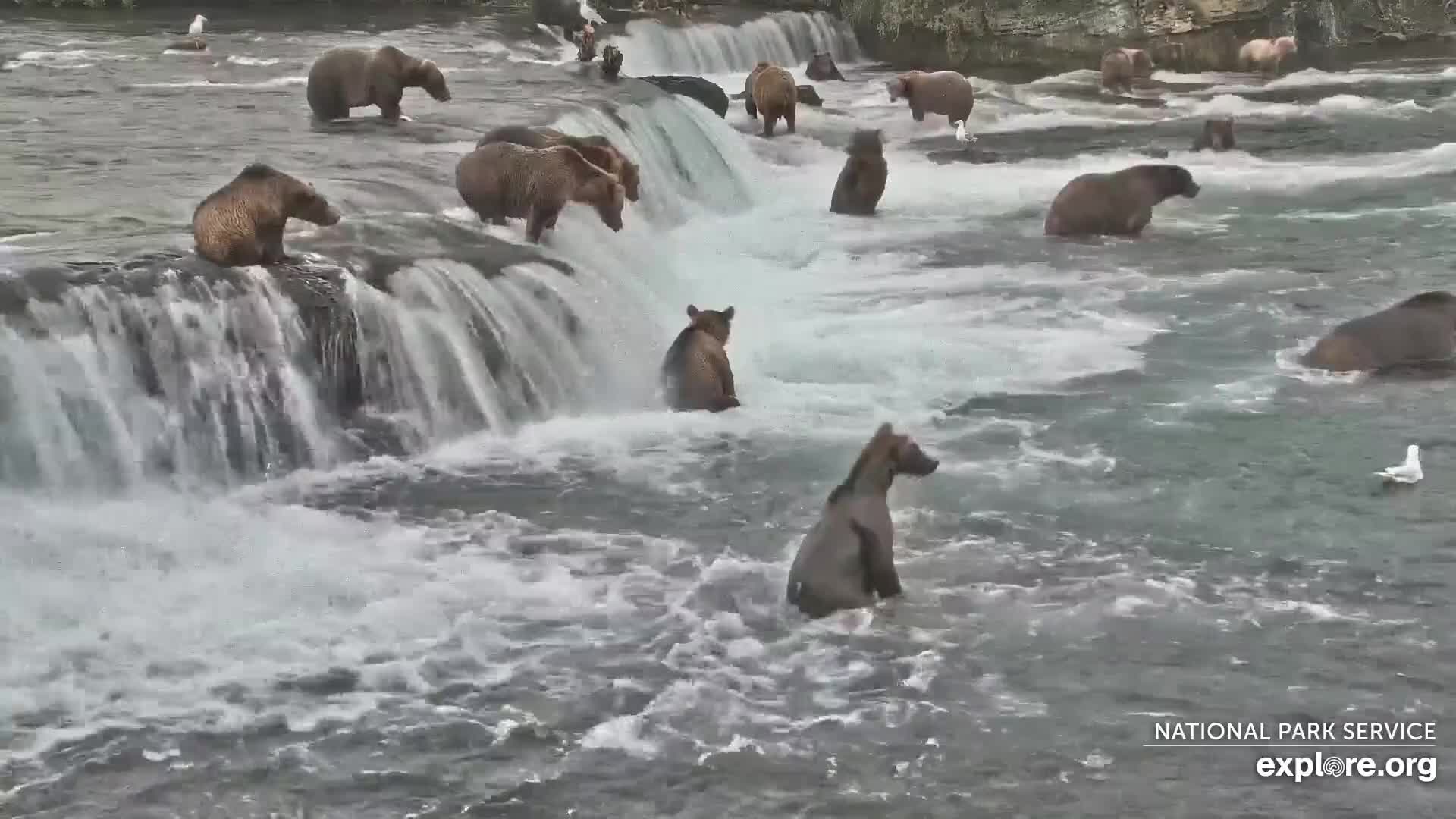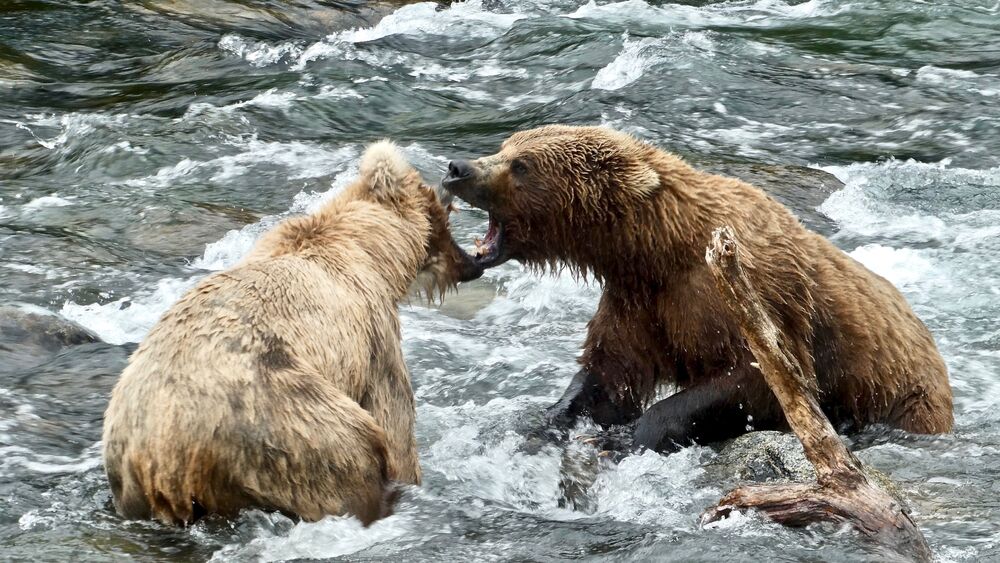By Mike Fitz
Perhaps no other group of bears captures our attention like mothers and their cubs. We empathize with their plight and wish them success. Mother bears often show a high tolerance for each other, almost as though they recognize their mutual problems.
In 2016, I watched 128 Grazer and 409 Beadnose back down from conflict instead of risking a fight in which they or their cubs might be injured. Read my full breakdown.
Bears have large appetites, though. They must eat a year’s worth of food in six months or less. Limited fishing success and empty stomachs increase the frequency and intensity of conflict between bears at Brooks Falls. Although bears avoid physical conflict most often, we still see them fight. How should we react when bears don’t play nice?

It’s been an unusual year at Brooks River so far. The salmon run was slow at first even as the number of salmon entering the greater watershed climbed above two million. It strengthened and increased in the river toward the end of July and has remained somewhat strong through much of early August. This has kept many bears around at a time of year when they usually disperse away from the river.
As recently as the beginning of the week, dozens of bears have been fishing within sight of Brooks Falls. Congregations like this don’t happen without some level of mutual tolerance, even as the bears warily eye and look to usurp fishing spots from each other.
Mother bears, in particular, must work especially hard to keep their cubs protected and well fed. They display their work ethic and devotion in subtle and overt ways. Some mother bears avoid areas with high numbers of bears, foregoing prime fishing opportunities to give their cubs greater security. As a group, though, no matter if they fish at the falls or elsewhere, mothers are the most defensive of all bears.
128 Grazer, for example, often isn’t willing to back down when another bear approaches her family too closely. If Grazer senses another bear might threaten her offspring, she confronts the threat head on. Under those circumstances her defensiveness extends to most all other bears. She’s defended her yearlings from the largest adult males as well as younger bears who maybe took too great of a risk to satisfy their own hunger.
Here is a cam highlight that shows Grazer defending her cubs against an adult male.
128 Grazer, 854 Divot, and their yearling cubs, engaged in a prolonged conflict over space and a fish on August 10, 2021. In my experience at Brooks River, it’s quite rare to see mother bears compete so vigorously with each other. This situation, interestingly, was precipitated by the yearlings. Grazer’s yearlings wanted a fish that Divot’s yearlings had in their possession. Divot felt the need to defend her yearlings. Each time Divot stepped in, she got too close to Grazer’s yearlings and that caused Grazer to react defensively. It was, for a moment, a feedback loop.
Grazer’s defensiveness, in particular, has provoked a wide range of reactions among webcam viewers, everything from awe to fright to concern to disdain for her aggressiveness. Some viewers have also wondered if Grazer poses an undue threat to other bears. She doesn’t FWIW, but this has got me wondering, once again, how do our human-centered perceptions of the world affect our reaction to the behavior of wild animals?
Although it elicits the ire of many people in the natural sciences, it’s sometimes difficult to not anthropomorphize animals. We are human and applying human characteristics to non-human creatures is common in literature and in real life. We usually have few qualms interpreting the feelings of our pets as sad, happy, or guilty even if our interpretations are sometimes incorrect. When we see Grazer beat up a small, seemingly non-threatening subadult bear, her behavior can seem harsh.
If I’m being honest with myself and you, her behavior is harsh. However, I use that word with caution. The act of being harsh may come loaded with negativity in our minds. I use it, therefore, not as a judgement but as a description.
For a moment, consider the world through Grazer’s eyes. She’s a sentient individual living in a difficult and competitive environment. Her survival and that of her cubs is not guaranteed. While bears are not as asocial as their reputations suggest, Grazer doesn’t live within a permanent social group. She’s devoted to her cubs, yet cannot rely on the help of other bears to raise them. Her species hasn’t evolved a sense of reciprocation. Like other bears, she establishes her place in the hierarchy through the use of body size, strength, and force. She senses the clock ticking perpetually toward winter, when she and her cubs must outwait famine by hibernating. Grazer faces those challenges daily.
If we can decouple the behavior of bears from the implications of the words we use to conceptualize their behavior—whether that’s moral or ethical—then perhaps we can more easily understand why bears make the decisions they do. Grazer is harsh toward other bears. Yet, her morals and rules for life are not our own. If I am to be fair to her, even as she is unfair to other bears, then I should consider life from her perspective rather than my culture’s and species’ rules for social engagement.
It’s okay to feel when we watch bears. We are emotional creatures, after all. Try as I might, I can’t fully channel my inner Spock well enough to remove myself emotionally from the bears’ lives. I only need to acknowledge that the bears’ minds, morals, and ethics are not human. Bears and other non-human creatures behave in ways that may clash with our values of right and wrong. And, that makes their behavior neither right nor wrong but something unique to them alone.



